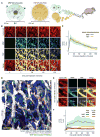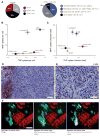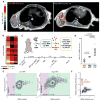Predicting therapeutic nanomedicine efficacy using a companion magnetic resonance imaging nanoparticle
- PMID: 26582898
- PMCID: PMC5462466
- DOI: 10.1126/scitranslmed.aac6522
Predicting therapeutic nanomedicine efficacy using a companion magnetic resonance imaging nanoparticle
Abstract
Therapeutic nanoparticles (TNPs) have shown heterogeneous responses in human clinical trials, raising questions of whether imaging should be used to identify patients with a higher likelihood of NP accumulation and thus therapeutic response. Despite extensive debate about the enhanced permeability and retention (EPR) effect in tumors, it is increasingly clear that EPR is extremely variable; yet, little experimental data exist to predict the clinical utility of EPR and its influence on TNP efficacy. We hypothesized that a 30-nm magnetic NP (MNP) in clinical use could predict colocalization of TNPs by magnetic resonance imaging (MRI). To this end, we performed single-cell resolution imaging of fluorescently labeled MNPs and TNPs and studied their intratumoral distribution in mice. MNPs circulated in the tumor microvasculature and demonstrated sustained uptake into cells of the tumor microenvironment within minutes. MNPs could predictably demonstrate areas of colocalization for a model TNP, poly(d,l-lactic-co-glycolic acid)-b-polyethylene glycol (PLGA-PEG), within the tumor microenvironment with >85% accuracy and circulating within the microvasculature with >95% accuracy, despite their markedly different sizes and compositions. Computational analysis of NP transport enabled predictive modeling of TNP distribution based on imaging data and identified key parameters governing intratumoral NP accumulation and macrophage uptake. Finally, MRI accurately predicted initial treatment response and drug accumulation in a preclinical efficacy study using a paclitaxel-encapsulated NP in tumor-bearing mice. These approaches yield valuable insight into the in vivo kinetics of NP distribution and suggest that clinically relevant imaging modalities and agents can be used to select patients with high EPR for treatment with TNPs.
Copyright © 2015, American Association for the Advancement of Science.
Conflict of interest statement
Figures






Comment in
-
Nanomedicine gets personal.Sci Transl Med. 2015 Nov 18;7(314):314fs47. doi: 10.1126/scitranslmed.aad6645. Sci Transl Med. 2015. PMID: 26582895
-
Magnetic resonance imaging-guided stratified selection of patients for nano-therapy.Ann Transl Med. 2016 Oct;4(Suppl 1):S54. doi: 10.21037/atm.2016.10.07. Ann Transl Med. 2016. PMID: 27868022 Free PMC article. No abstract available.
References
-
- Chow EK, Ho D. Cancer nanomedicine: from drug delivery to imaging. Sci Transl Med. 2013;5:216rv4. - PubMed
-
- Maeda H, Nakamura H, Fang J. The EPR effect for macromolecular drug delivery to solid tumors: Improvement of tumor uptake, lowering of systemic toxicity, and distinct tumor imaging in vivo. Adv Drug Deliv Rev. 2013;65:71. - PubMed
Publication types
MeSH terms
Substances
Grants and funding
LinkOut - more resources
Full Text Sources
Other Literature Sources
Medical
Miscellaneous

